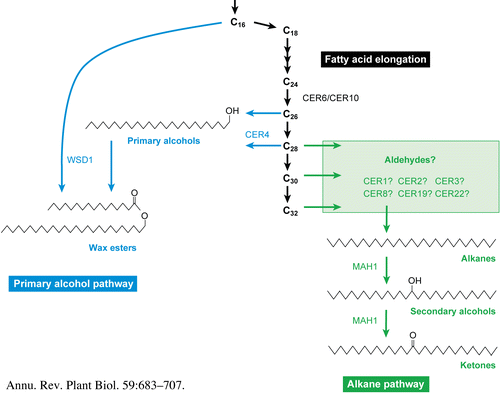The cuticle
The cuticle is a thin hydrophobic layer which covers the outermost surface of the primary aerial tissues of land plants. It protects plants from uncontrolled water loss, UV radiation, as well as bacterial and fungal pathogens. It also mediates a variety of plant interactions with insects and prevents fusions between plant organs during development. The cuticle is synthesized by epidermal cells and its framework is provided by cutin, an insoluble plant-specific polyester composed of C16 and C18 hydroxy and epoxy fatty acids and glycerol. The cutin matrix is embedded in and overlaid with cuticular waxes, complex mixtures of mostly very-long-chain fatty acid (VLCFA) derivatives easily extractable by organic solvents.
Wax biosynthesis
Major wax components are long-chain aliphatic compounds derived from saturated very long chain fatty acids (VLCFAs), with chain lengths from 20 to 34 carbons. VLCFA wax precursors are synthesized by sequential addition of 2-carbon moieties to the 18-carbon fatty acids made de novo in the plastid. This process is catalyzed by a 4-enzyme ER-membrane-bound fatty acid elongation (FAE) system. VLCFAs generated in the epidermis are then used for the production of other wax components, such as aldehydes, primary and secondary alcohols, alkanes, ketones, and esters via two wax biosynthetic pathways: the primary alcohol (acyl reduction) pathway and the alkane (decarbonylation) pathway.
Similar wax constituents comprising cuticular wax of most plant species suggest that the basic mechanisms involved in wax production and transport to the cuticle are highly conserved in the plant kingdom, but our understanding of these processes is limited. We are using wax-deficient eceriferum mutants as well as reverse genetic approaches in Arabidopsis thaliana to:
-
identify and functionally characterize gene products involved in wax biosynthesis and secretion
-
gain insights into regulation of wax deposition in epidermal cells
-
establish subcellular localization of the enzymes of wax biosynthesis, and
-
determine the mechanism of wax transport to the cuticle

